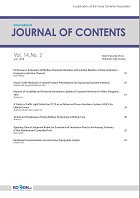- Log In/Sign Up
- P-ISSN1738-6764
- E-ISSN2093-7504
- KCI
 ISSN : 1738-6764
ISSN : 1738-6764
Vol.2 No.3
Abstract
Intelligent Content is defined as detailed information or fragment of content which contains a semantic data structure. This semantic structure makes possible to do various intelligent operations. There are wide range of content-oriented applications such as classification, retrieval, extraction, translation, presentation and question-answering. The concept of Intelligent Content is applied to various fields like MPEG and Semantic Web. In this paper, we discuss the several important researches of Intelligent Content and how to apply this conception to these fields.
Abstract
Small molecule OLED devices were fabricated and the electro-optical characteristics were analyzed. The luminance and color coordinate of the fabricated OLED device were <TEX>$24,390cd/m^2$</TEX> and (x=0.15, y=0.22), respectively. Current efficiency of 6.8 cd/A and power efficiency of 2.4 lm/W were also obtained under DC operating condition. Transient light intensity was also measured by using Si photodiode.
Abstract
The Clustering is representative method of components classification. The previous clustering methods that use cohesion and coupling cannot be effective because design pattern has focused on relation between classes. In this paper, we classified design patterns with features of object-oriented relationship. The result is that classification by clustering showed higher precision than classification by facet. It is effective that design patterns are classified by automatic clustering algorithm. When patterns are retrieved in classification of design patterns, we can use to compare them because similar pattern is saved to same category. Also we can manage repository efficiently because of storing patterns with link information.
Abstract
Nowadays, many people enjoy playing games in computer. In this kind of game, people often meet NPC (Non Player Character). It is the virtual character in simplified form of real player and exits in most of current computer games. Various NPCs add the reality and atmosphere of the game as well as help players. There are several techniques to embody NPC, but developers generally use AI technique. This paper discusses some artificial intelligence techniques used in game contents. Especially this paper focuses on the AI techniques used in computer games in terms of the two main approaches, symbolic approach and sub-symbolic approach.
Abstract
In this paper we introduce a new circle detection algorithm for occluded on/off pupil and iris boundary extraction. The proposed algorithm employs 7-step processing to detect a center and radius of occluded on/off eye images using the property of the chords. The algorithm deals with two types of occluded pupil and iris boundary information; one is composed of circle-shaped, incomplete objects, which is called occluded on iris images and the other type consists of arc objects in which circular information has partially disappeared, called occluded off iris images. This method shows that the center and radius of iris boundary can be detected from as little as one-third of the occluded on/off iris information image. It is also shown that the proposed algorithm computed the center and radius of the incomplete iris boundary information which has partially occluded and disappeared. Experimental results on RGB images and IR images show that the proposed method has encouraging performance of boundary detection for pupil and iris segmentation. The experimental results show satisfactorily the detection of circle from incomplete circle shape information which is occluded as well as the detection of pupil/iris boundary circle of the occluded on/off image.
Abstract
We present an effective algorithm for automatic tracing of retinal vessel structure and vascular landmark extraction of bifurcations and ending points. In this paper we deal with vascular patterns from RGB images for personal identification. Vessel tracing algorithms are of interest in a variety of biometric and medical application such as personal identification, biometrics, and ophthalmic disorders like vessel change detection. However eye surface vasculature tracing in RGB images has many problems which are subject to improper illumination, glare, fade-out, shadow and artifacts arising from reflection, refraction, and dispersion. The proposed algorithm on vascular tracing employs multi-stage processing of ten-layers as followings: Image Acquisition, Image Enhancement by gray scale retinal image enhancement, reducing background artifact and illuminations and removing interlacing minute characteristics of vessels, Vascular Structure Extraction by connecting broken vessels, extracting vascular structure using eight directional information, and extracting retinal vascular structure, and Vascular Landmark Extraction by extracting bifurcations and ending points. The results of automatic retinal vessel extraction using jive different thresholds applied 34 eye images are presented. The results of vasculature tracing algorithm shows that the suggested algorithm can obtain not only robust and accurate vessel tracing but also vascular landmarks according to thresholds.
